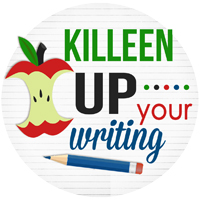I don’t know what to write! By this point in the year, you will have prior knowledge of your students’ interests and you may pull from those experiences.
The Class Wanderer: Sometimes we get students who like, or possibly need, to wander around the class. Through no fault of their own, maybe they get a little antsy. You may praise, or set up a reward system, with the student when he/she is seated for a period of time. Another solution is to give the student two seats. He/She must be on his/her way from seat A to seat B, or from seat B to seat A, only. Giving students wiggle cushions or alternate seating that rocks/wiggles can decrease the amount of time wandering. The goal is to give students appropriate outlets for a very real problem.
Working standing up: I have no problem with students who choose to stand during writing time. If standing works for the student, then it works for me.
Sharing Out/Risk Taking: Give students an opportunity to share out written pieces, or segments from an entry. Students want others to hear what they write. They will learn “writerly moves” from each other. I never put anybody on the spot and this is strictly optional in my class. Remember…when you take risks by sharing your own written work with students...they will also take risks and share out.
“Is this good?” Students are never allowed to ask me if their work is good. I want my students to reach for the stars. I encourage students to ask questions such as: “What can I do to make this writing even better than it is now?” “How can I improve this section?” “How can I make this narrative more amazing?”
“If better is possible, then good isn’t enough.” -Benjamin Franklin
How do you spell _______? We practice dictionary skills early in the year. I want my class to know how to use the dictionary independently. If students want to know how to spell a word, then they need to use their dictionary or ask a neighbor. You don’t want students leaving their seat to ask how to spell a word. Students can also place their hand under their chin. Every time their jaw drops while saying a word indicates a syllable and vowel. (Ar-i-zon-a) four drops…four syllables…four vowels
I can’t find a pencil! I always have a group of sharpened pencils in the same spot all year long. Students exchange their dull pencil for a sharp one. Also, I have a suggestion for the students who always lose their pencils. Tie one end of a string to the bottom side of the desk and the opposite end to the eraser tip of a pencil. The pencil will always be waiting for use.
I’m done: "When you are done, then you have just begun." A student said that one-day and I loved the idea. I don’t know where she heard this, but it was genius. Students have to go back and self-regulate, edit, revise, or make any other changes to their writing when they “think” they are done.
Unlocking imaginations one lesson at a time!




























